Pulp : tents for the camp of the explorers
All respected explorer goes for few days in a desert, hostile place, in which he will need a cover where pass the night. That's while it can be interesting to have some tents to set the encampment of your explorers, I explain to you how to proceed to make a decor like this :

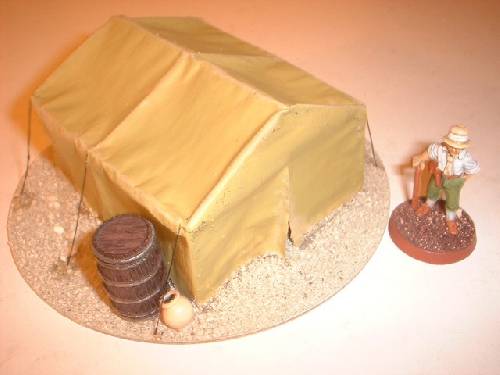
Needed material
- Wire (0.5 mm thick for the frame, 0.2 mm for the tension strings)
- 1 soldering iron, tin (for younger and less gifted, careful not to burn you ...), a third hand may also help
- Newspaper
- paper glue, white glue, and if you have, varnish glue Decopatch. The latter is also available in shops in creative leisure, but no need to buy just for this occasion: the wood glue thinned with water can also be suitable for that we will do.
- Some decorative elements to make your camp more alive (a few boxes, a barrel ...)
Technique
Like a real tent, we will begin by the frame. First, I cut 3 pieces of wire (0.5mm) of 12.5cm of length, and 3 others of 7.5cm. Using theses measures allows to stay in the proportions of 25-28mm minis, but you can make tents smaller or bigger with the same technique.
After folding, the pieces of 12.5cm allows to obtain the vertical jambs of our installation. On the picture bellow, the jambs are folded at 3cm of height, and a light slope for the roof is done, for a total height of 4cm, and a width of 6.5cm.
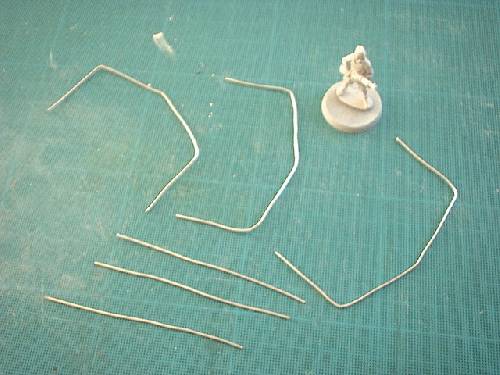
The next step is to assemble the frame in welding it. That's here that a third hand is helpful and allows you to make the assembly at right angles. When done, you can have something like this :
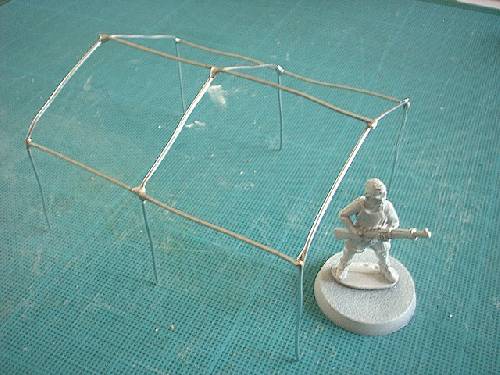
Before covert our frame, it's inserted on its base. It's more practical to fix the frame onto the base with a glue gun, but white glue can also be suitable. Also, keep in mind to prepare the flocking inside the tent (if visible) before pass to the next step :
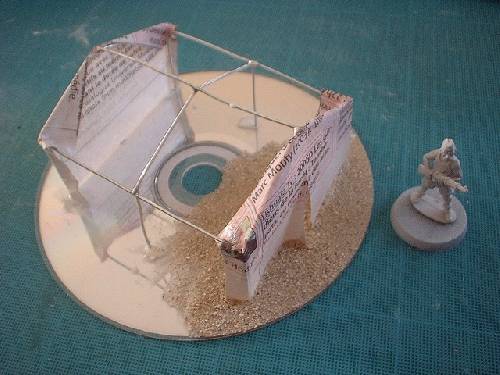
Like you can see on the picture above, I begin to covert the front and the rear of the tent. Two squares of newspaper, lightly bigger than necessary, are glued with paper glue. What which exceeds is folded on the side and on the top, it allows us later to join with the rest of the tent.
The sides and the roof are covered with an unique stripe of newspaper (about 13cm x 7.5), glued with varnish glue or white glue diluted of water. For a better grip at joint levels, and also to let the paper take the form of the frame, I advise you to humidify the newspaper during the pose.
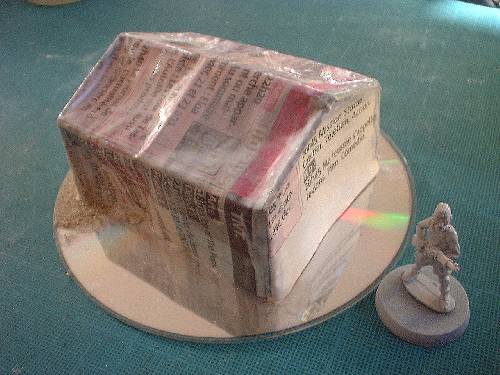
To finish, think to the details who allows your encampment to pick up life : tension strings of the tent, applied at the top of the vertical jambs (here, with 0.2mm wire, glued with paper glue), but also some hardware used by your explorers during their trip, crates, supplies, water (warning : camp fires are banished next to the tent...)
If your explorers are scientists, maybe they're keeping some results of their studies next to their tent ? Unless it's an improvised table were they can have a meal ? Or even some big game trophies ?...
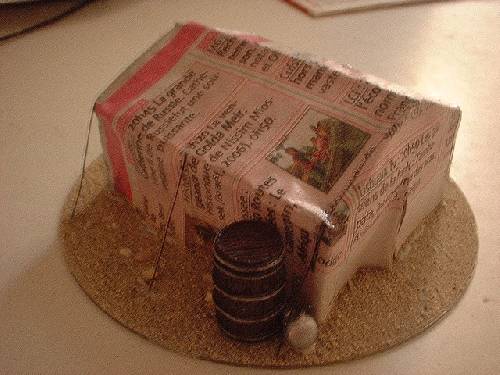
After finished, the tent is painted with acrylic, in a 50/50 mix of "camo green" and "elf flesh" from Games Workshop. Lightening is made with pure "elf flesh". This color is near of the olive drab used for the German's tropical uniforms during WW2 (type "Afrika Corps"), so I can recycle my tents with other miniatures than my explorers.

Needed material
- Wire (0.5 mm thick for the frame, 0.2 mm for the tension strings)
- 1 soldering iron, tin (for younger and less gifted, careful not to burn you ...), a third hand may also help
- Newspaper
- paper glue, white glue, and if you have, varnish glue Decopatch. The latter is also available in shops in creative leisure, but no need to buy just for this occasion: the wood glue thinned with water can also be suitable for that we will do.
- Some decorative elements to make your camp more alive (a few boxes, a barrel ...)
Technique
Like a real tent, we will begin by the frame. First, I cut 3 pieces of wire (0.5mm) of 12.5cm of length, and 3 others of 7.5cm. Using theses measures allows to stay in the proportions of 25-28mm minis, but you can make tents smaller or bigger with the same technique.
After folding, the pieces of 12.5cm allows to obtain the vertical jambs of our installation. On the picture bellow, the jambs are folded at 3cm of height, and a light slope for the roof is done, for a total height of 4cm, and a width of 6.5cm.

The next step is to assemble the frame in welding it. That's here that a third hand is helpful and allows you to make the assembly at right angles. When done, you can have something like this :

Before covert our frame, it's inserted on its base. It's more practical to fix the frame onto the base with a glue gun, but white glue can also be suitable. Also, keep in mind to prepare the flocking inside the tent (if visible) before pass to the next step :

Like you can see on the picture above, I begin to covert the front and the rear of the tent. Two squares of newspaper, lightly bigger than necessary, are glued with paper glue. What which exceeds is folded on the side and on the top, it allows us later to join with the rest of the tent.
The sides and the roof are covered with an unique stripe of newspaper (about 13cm x 7.5), glued with varnish glue or white glue diluted of water. For a better grip at joint levels, and also to let the paper take the form of the frame, I advise you to humidify the newspaper during the pose.

To finish, think to the details who allows your encampment to pick up life : tension strings of the tent, applied at the top of the vertical jambs (here, with 0.2mm wire, glued with paper glue), but also some hardware used by your explorers during their trip, crates, supplies, water (warning : camp fires are banished next to the tent...)
If your explorers are scientists, maybe they're keeping some results of their studies next to their tent ? Unless it's an improvised table were they can have a meal ? Or even some big game trophies ?...

After finished, the tent is painted with acrylic, in a 50/50 mix of "camo green" and "elf flesh" from Games Workshop. Lightening is made with pure "elf flesh". This color is near of the olive drab used for the German's tropical uniforms during WW2 (type "Afrika Corps"), so I can recycle my tents with other miniatures than my explorers.
Retour aux articles de la catégorie Tips and tricks -
⨯
Inscrivez-vous au blog
Soyez prévenu par email des prochaines mises à jour
Rejoignez les 19 autres membres
